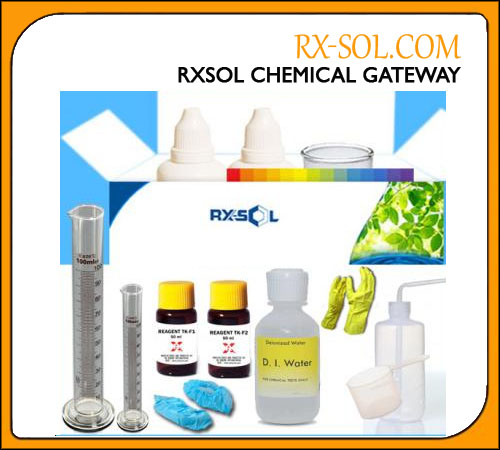Buffer Cleaner
Oman Chemical is leading one Largest Supplier, Manufacture a

TPTZ method is most common method for low range Iron determination from the sample.
The test may be utilized to monitor the effectiveness of corrosion mitigation programs and to keep track of general corrosion within a fire sprinkler system.
Ferrous iron is oxidized to ferric iron, causing a red appearance in the water within the test ampoule. The degree of redness is a direct relationship to the amount of dissolved iron within the sample water. Dissolved iron is a good indication of the general occurrence of total corrosion occurring within a fire sprinkler system.
Test Procedure:
1. Let the water run from the source to be tested for about 15 seconds.
2. Fill the 120 cc bottle at least ½ full.
3. Remove the protective cap from the end of the syringe.
4. Place the tip of the syringe in the bottom of the 120 cc bottle so it is submerged.
5. Grip the syringe with your fingers and place your thumb on the top of the test ampoule as if you were going to inject the syringe into the bottom of the 120 cc bottle.
6. Push down on the test ampoule with your thumb while keeping the tip submerged.
7. The tip of the ampoule will automatically break. The vacuum will automatically draw the water into the ampoule.
8. When the ampoule is full, remove the syringe from the 120 cc bottle.
9. Turn the syringe so the open end points up.
10. Rock the syringe back and forth about 30 seconds to mix the test reagent.
11. Compare the color of the water to the color chart in Fig. 1
12. The degree of “redness” indicates the level of iron in the water
1-5 ppm indicates low corrosion rates
5-10 ppm indicates high corrosion rates
Important:
The test ampoule inside the syringe is under a vacuum. DO NOT push the ampoule into the syringe unless the tip is exposed and completely submerged in water to be tested.
Failure to follow this procedure will break the tip of the ampoule releasing the vacuum and rendering the test kit useless.
Note:
When flowing water in a sprinkler system, care should be taken to prevent unwanted waterflow alarms.
The water for the iron test can be obtained from anywhere in the sprinkler system such as the 2” main drain, inspectors test valve, corrosion monitoring station, auxiliary drain, etc.
Disposal
Ampoule may be discarded in regular trash services. Care should be taken not to cut yourself, or others, with exposed glass tip.
Shelf Life
Ampoules are accurate for two years after purchase, if tip is not broken.
Certification
The testing uses the 1-10 Phenanthroline method adopted from, “Standard Test Methods of Water and Wastewater” 15th edition 201 (1980). Fire sprinkler systems that contain high levels of dissolved iron and have been treated with Potter Pipe-Shield may still indicate high levels of corrosion when tested with the Potter iron test.
This is due to the fact the dissolved iron is still in the system. As the iron is flushed out during regular waterflow tests, flushing or draining the system for service, the tests will indicate less dissolved iron in the system.
2,4,6- Tris-(2’ - Pyridyl )-s-Triazine ( TPTZ ) or also can be use like 2,4,6-Tripyridyl-s-triazine. Solution of (TPTZ), .001 M were prepared by dissolving 0.312 gram of compound in a view drops of hydrochloric acid and diluting to 1 ltr with water.